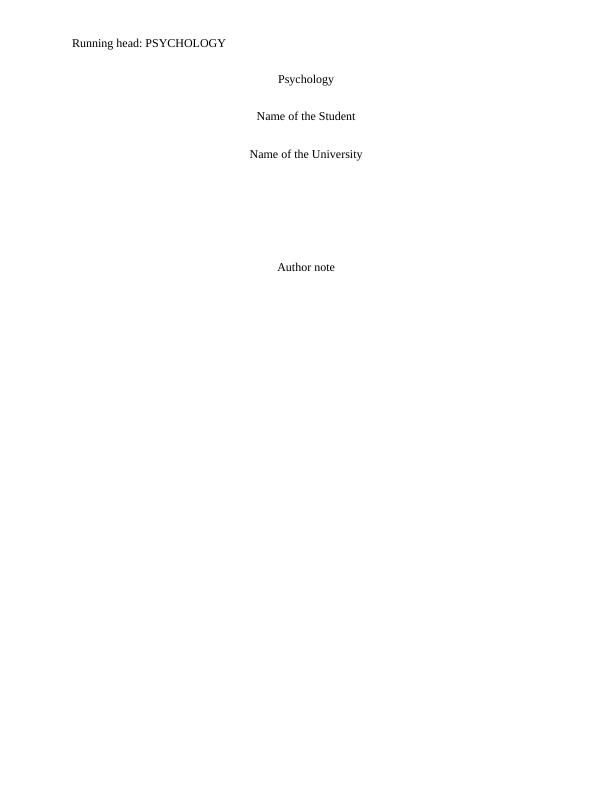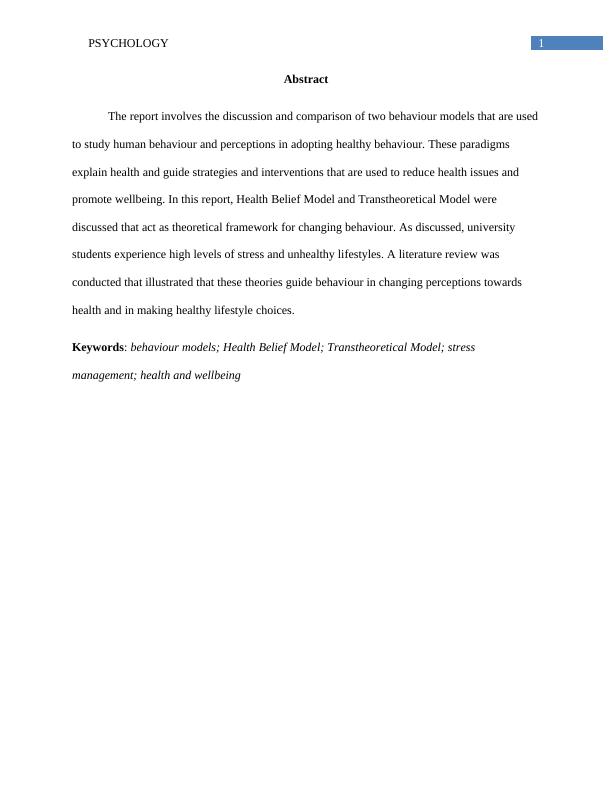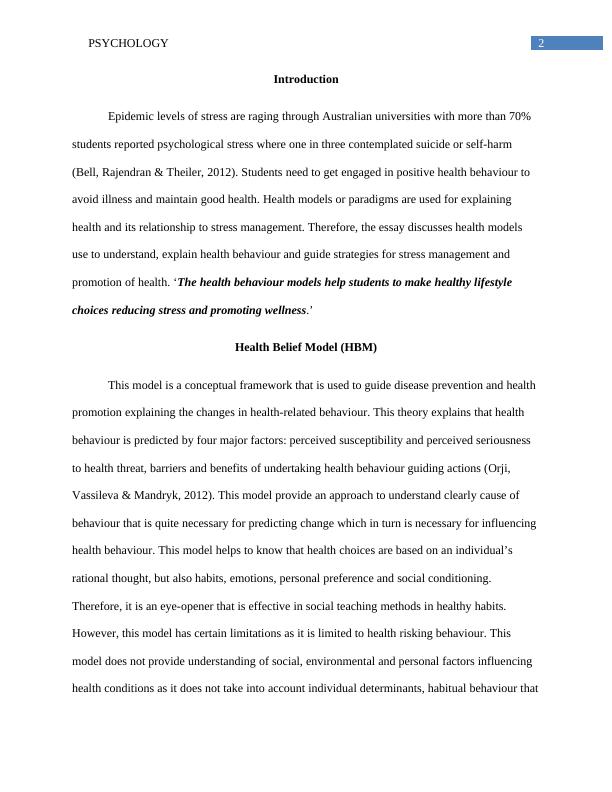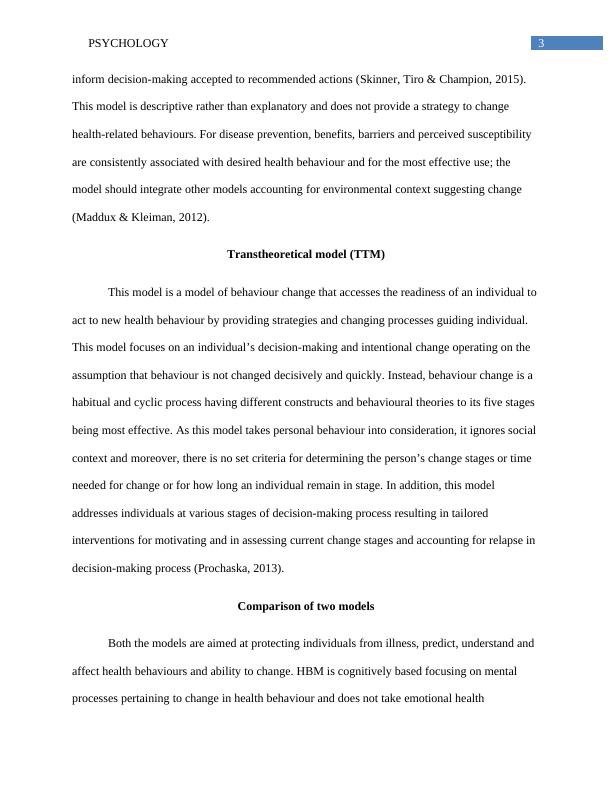PSY140 Psychology Assignment
Added on 2020-05-28
12 Pages2761 Words314 Views
Running head: PSYCHOLOGYPsychologyName of the StudentName of the UniversityAuthor note

1PSYCHOLOGYAbstractThe report involves the discussion and comparison of two behaviour models that are usedto study human behaviour and perceptions in adopting healthy behaviour. These paradigms explain health and guide strategies and interventions that are used to reduce health issues and promote wellbeing. In this report, Health Belief Model and Transtheoretical Model were discussed that act as theoretical framework for changing behaviour. As discussed, university students experience high levels of stress and unhealthy lifestyles. A literature review was conducted that illustrated that these theories guide behaviour in changing perceptions towards health and in making healthy lifestyle choices. Keywords: behaviour models; Health Belief Model; Transtheoretical Model; stress management; health and wellbeing

2PSYCHOLOGYIntroduction Epidemic levels of stress are raging through Australian universities with more than 70% students reported psychological stress where one in three contemplated suicide or self-harm (Bell, Rajendran & Theiler, 2012). Students need to get engaged in positive health behaviour to avoid illness and maintain good health. Health models or paradigms are used for explaining health and its relationship to stress management. Therefore, the essay discusses health models use to understand, explain health behaviour and guide strategies for stress management and promotion of health. ‘The health behaviour models help students to make healthy lifestyle choices reducing stress and promoting wellness.’ Health Belief Model (HBM)This model is a conceptual framework that is used to guide disease prevention and health promotion explaining the changes in health-related behaviour. This theory explains that health behaviour is predicted by four major factors: perceived susceptibility and perceived seriousness to health threat, barriers and benefits of undertaking health behaviour guiding actions (Orji, Vassileva & Mandryk, 2012). This model provide an approach to understand clearly cause of behaviour that is quite necessary for predicting change which in turn is necessary for influencing health behaviour. This model helps to know that health choices are based on an individual’s rational thought, but also habits, emotions, personal preference and social conditioning. Therefore, it is an eye-opener that is effective in social teaching methods in healthy habits. However, this model has certain limitations as it is limited to health risking behaviour. This model does not provide understanding of social, environmental and personal factors influencing health conditions as it does not take into account individual determinants, habitual behaviour that

3PSYCHOLOGYinform decision-making accepted to recommended actions (Skinner, Tiro & Champion, 2015). This model is descriptive rather than explanatory and does not provide a strategy to change health-related behaviours. For disease prevention, benefits, barriers and perceived susceptibility are consistently associated with desired health behaviour and for the most effective use; the model should integrate other models accounting for environmental context suggesting change (Maddux & Kleiman, 2012). Transtheoretical model (TTM)This model is a model of behaviour change that accesses the readiness of an individual to act to new health behaviour by providing strategies and changing processes guiding individual. This model focuses on an individual’s decision-making and intentional change operating on the assumption that behaviour is not changed decisively and quickly. Instead, behaviour change is a habitual and cyclic process having different constructs and behavioural theories to its five stages being most effective. As this model takes personal behaviour into consideration, it ignores social context and moreover, there is no set criteria for determining the person’s change stages or time needed for change or for how long an individual remain in stage. In addition, this model addresses individuals at various stages of decision-making process resulting in tailored interventions for motivating and in assessing current change stages and accounting for relapse in decision-making process (Prochaska, 2013). Comparison of two models Both the models are aimed at protecting individuals from illness, predict, understand and affect health behaviours and ability to change. HBM is cognitively based focusing on mental processes pertaining to change in health behaviour and does not take emotional health

End of preview
Want to access all the pages? Upload your documents or become a member.
Related Documents
Promoting Health: Using the Health Belief Model to Increase Exercise for Cardiovascular Healthlg...
|6
|863
|217
Health Promotion: Theories, Models and Behaviour Changelg...
|11
|2780
|488
Health Belief Model and its Application on Tobacco Cessation-Smokinglg...
|6
|1672
|109
Transtheoretical Model of Change and Motivational Interviewing for Successful Total Knee Replacementlg...
|9
|2388
|286
Public Health Resourcelg...
|2
|855
|47
Health Belief Model (HBM)lg...
|13
|3562
|1
